When it comes to technical fibres and design, sleeping bags have come a long way in the last few decades, with more recent developments recognising the practicality and warmth of traditional natural fillings and environmentally friendly manufacture methods. All of which means there is plenty of choice out there, whichever type of camper you are.
Such a level of choice can sometimes appear confusing. With a huge price range and plenty of technical details, shopping for a sleeping bag may seem complicated but all it really comes down to is one simple question, 'When, where and how do you plan to go camping?’ Find out about materials, additional features and temperature ratings in our buyer's guide.
Read on for our review of the best three-season, lightweight, synthetic and down sleeping bags of 2024.
At a glance: best sleeping bags on test
- Best on test: The Sierra Designs Cloud 800 35 Degree Down - Amazon (£334.95)
- Best for two season camping: Rab Women's Ascent 500 Down Sleeping Bag (-5C) - Ellis Brigham (£270.00)
- Best for campsite camping in summer: The Easy Camp Moon 200 - Amazon (£30.97)
Reviews edited by Rachel Howatson
Best sleeping bags to buy for 2024
Robens Icefall Pro 300 sleeping bag
Best for light and fast summer camping
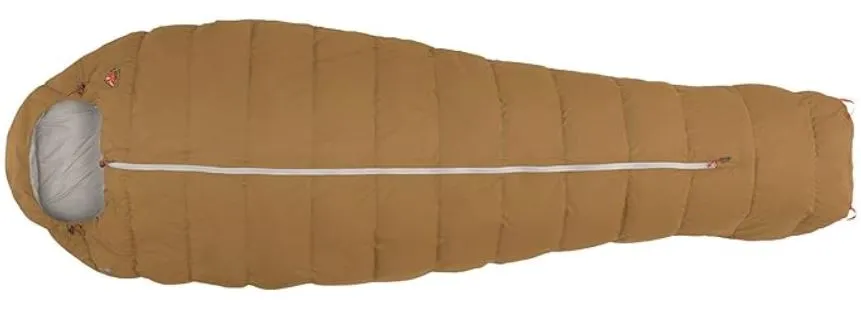
Pros: Super-soft, moisture-resistant, lofts like down, compression bag included
Cons: Tight fit, no women's specific design
- RRP: £143.99
- Shape: ‘Technical mummy’
- Fill: 300g fill weight, 600 fill power of synthetic MicroThermo Ball
- Weight: 645g
- Packed size: 34cm x 17cm
- Comfort rating (European Standard 13537): Comfort temperature 11°C (lower temperature –7°C)
If you're on the lookout for a synthetic sleeping bag that feels like down, the Robens Icefall Pro 300 is worth considering. Ultra-lightweight and super soft, this is one for the backpackers who enjoy a touch of luxury when they rest up for the night.
As a 'technical mummy', the design is fairly tight, so if you like to air out your feet you may find it restrictive, but that's where the central front zip comes in handy. Plus, an adjustable waist cord lets you keep your bottom half nice and toasty whilst you sit up – a nice touch, especially when you take the time to enjoy a morning brew.
Check out our full Robens Icefall Pro 300 sleeping bag review.
Sierra Designs Cloud 800 35 Degree Down sleeping bag
Best on test
Buy from Wildbounds (£299.95 £220.95)
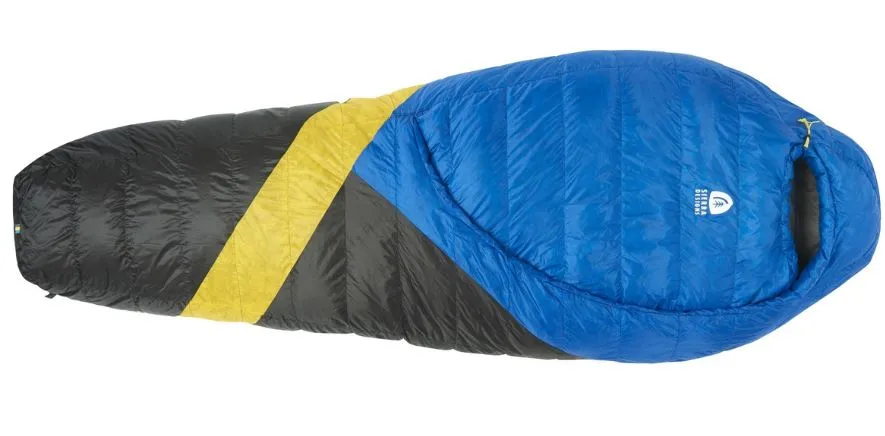
Pros: Zipless design, hydrophobic down, ideal temperature control
Cons: Camping mattress required
- RRP: from $299.95
- Shape: Zipless mummy
- Fill: 268g fill weight, 800 fill power hydrophobic down
- Weight: 660g
- Packed size: 33cm x 18cm
- Comfort rating (European standard 13537): Comfort temperature 2°C (lower temperature –3°C)
Sierra Designs' innovative no-zip sleeping bag is a winner for us: lightweight, great temperature control and packed with impressive technical details. The hydrophobic down filled design combines the cosiness of a sleeping bag with the freedom of a quilt, so you've got the best of both worlds. There's also a sleeve for your sleeping mat – ideal for active sleepers.
A great choice for stuffy sleepers too, there's a handy foot vent for that all-important burst of cold air.
You can find out more in our review of the Sierra Designs Cloud 800 35 Degree Down sleeping bag.
Snugpak Travelpak Traveller sleeping bag
Best for long trips
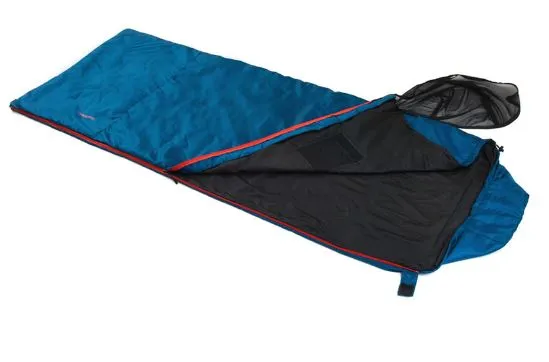
Pros: Compression sack, built-in mosquito net, quilt-like qualities
Cons: Sticky zips on the mosquito net, feels synthetic
- RRP: £57
- Shape: Rectangular
- Fill: Synthetic polyester
- Weight: 900g
- Packed size: 15cm x 18cm
- Comfort rating (manufacturer’s own): Comfort temperature 7°C (lower temperature 2°C)
In the affordable range of the price scale, Snugpak's Travelpak Traveller will suit those travelling in warmer climes. While this sleeping bag is a touch crackly, it feels robust and comes with a compression sack, making it a travel-friendly option.
The built-in mosquito net is another bonus, for that peace of mind as you drift off surrounded by midges in the Scottish Highlands, or more exotic insects overseas.
You'll want to save this sleeping bag for warmer summer evenings in the UK, but you may find the versatility of the design useful all year round as the sleeping bag opens up like a quilt.
Still undecided? Find out more in our full length Snugpak Travelpak Traveller sleeping bag review.
For cooler evenings, check out the Snugpak Travelpak 4 Sleeping Bag.
Rab Women's Ascent 500 Down Sleeping Bag (-5C)
Best for two-season camping
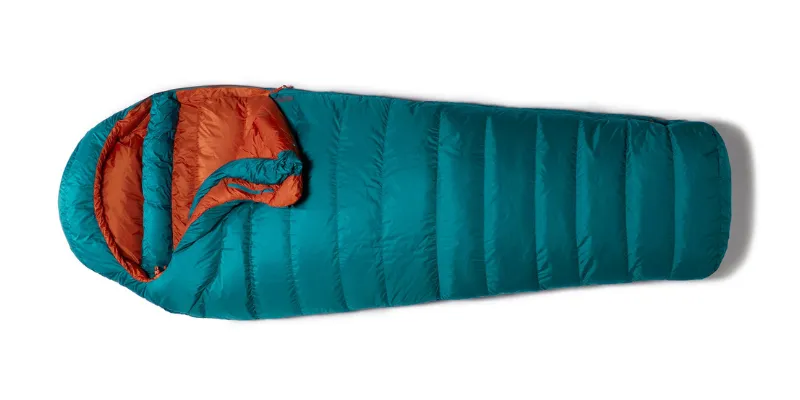
Pros: Female-specific shape, impressive attention to detail, comfortable
Cons: Expensive
- RRP: £270
- Shape: Generous mummy with female shaping
- Fill: 500g of 650 fill power duck down
- Weight: 1025g
- Packed size: 35cm x 20cm
- Comfort rating (European standard 13537): Comfort temperature 1°C (lower temperature -5°C)
For a soft, comfortable and lofty sleeping bag, Rab's Women's Ascent 500 Down could be for you. The female-specific design features a two-way zip, and plenty of wriggle room. Filled with 500g of 650 fill power hydrophobic duck down, this sleeping bag offers a soft and luxurious feel, and thanks to the spacious design, you can really curl up.
Read our full Rab Women's Ascent 500 Down Sleeping Bag review.
For a lightweight, compact design, read our review of the Rab Solar Eco 2 sleeping bag.
Quest Women's Synthetic Sleeping Bag
Best for entry-level backpacking in summer

Pros: Becomes a quilt, women-specific shaping
Cons: Just fits in the bag, short for tall women
- RRP: £135
- Shape: Relaxed mummy
- Fill: Synthetic. WaveLoft Polyester
- Weight: 1030g
- Packed size: 35cm x 20cm
- Comfort rating European standard 13537: Comfort temperature 3°C (lower temperature not given)
Quest's synthetic sleeping bag is another women-specific sleeping bag to consider, as a more entry-level, budget-friendly model.
You won't find this synthetic sleeping bag as warm as its down equivalents, but it would work well for entry level backpacking summer trips. It's on the shorter side, but we appreciated the generous mummy shape and additional space in the hip area. Plus, the sleeping bag fully unzips, so you could even use it as an additional quilt in the winter when you're sitting around the campsite and looking to layer up.
For more detail, read our full length review of the Quest Women's Synthetic Sleeping Bag.
Vango Zenith 200 sleeping bag
Best for camping in midge-prone areas

Pros: Recycled materials, mosquito nets included, reversible compression sack
Cons: Bulky, complicated set up
- RRP: £80
- Shape: Mummy
- Fill: Recycled synthetic filling
- Weight: 1,600g
- Packed size: 24cm x 20cm
- Comfort rating (manufacturer’s own): Comfort temperature 6°C (lower temperature 1°C)
On test, the Vango Zenith 200 proved tricky to pack away and it's fairly bulky. This makes it a more suitable fit for campsite camping, rather than backpacking. It lacks the softness and comfort of some of the other sleeping bags reviewed, reflecting the bag's lower price.
On the plus side, the two mosquito nets allow for ventilation on stuffy evenings, and the well-padded shoulder baffles, paired with the cinchable hood, earn this bag insulation points, despite the manufacturer’s 2-season claim. Both the fabrics and synthetic filling are made from recycled single-use plastics.
Want to know more? Check out our full length review of the Vango Zenith 200 sleeping bag.
Outwell Contour Lux sleeping bag
Best for glamping
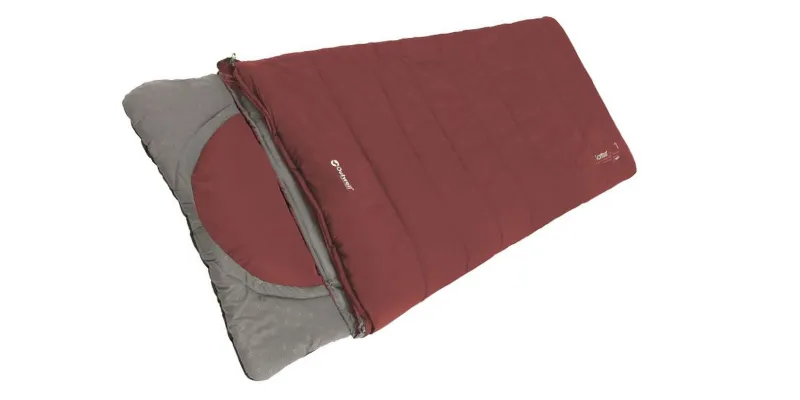
Pros: Built-in pillow, comes with compression sack, both warm and cold temperature ratings
Cons: Heavy to carry, could be draughty
- RRP: £71.99
- Shape: Rectangular
- Fill: Isofill polyester
- Weight: 1,700g
- Packed size: 42cm x 24cm
- Comfort rating European standard 13537: Comfort temperature 3°C or 15°C (lower temperature -3°C or 11°C)
With its dual temperature ratings, the Outwell Contour should be suitable for all-year-round use, but compared to the more technical sleeping bags, it lacks some of those all-important warmth-retaining features. The bag’s interior however is lovely and soft, and feels similar to bedding you’d have at home — a nice choice for a weekend’s glamping. The built-in pillow is a welcomed touch, but it could be more supportive.
This is a generously sized sleeping bag, and if you're a fussy sleeper when it comes to finding your perfect temperature, the cool-side, warm-side design is sure to come in handy.
Read our full length review of the Outwell Contour Lux sleeping bag.
Easy Camp Moon 200 sleeping bag
Best for campsite camping in summer

Pros: Great value, very soft, quilt-like qualities
Cons: No shoulder baffle
- RRP: £38.99
- Shape: Rectangular
- Fill: Polyester hollow fibre
- Weight: 1,470g
- Packed size: 38cm x 21cm
- Comfort rating (European standard EN 13537): Comfort temperature 7°C (lower temperature 2°C)
Easy Camp's Moon 200 sleeping bag impressed on test as a budget-friendly, super soft design. It's too big for backpacking, but it won't take up too much precious car space, packing down neatly into the carry sack.
You've got the option to open the bag up as a quilt on warmer evenings, and there's a drawstring on the hood and a generous zip baffle for when you're feeling the chill.
If you're a summer camper who prioritises the softness of fabric, the Easy Camp Moon 200 is a worthwhile investment.
You can find out more in our full length review of the Easy Camp Moon 200 sleeping bag.
Nemo Equipment Disco Women’s Down sleeping bag
Best for camping from a vehicle across spring, summer and autumn
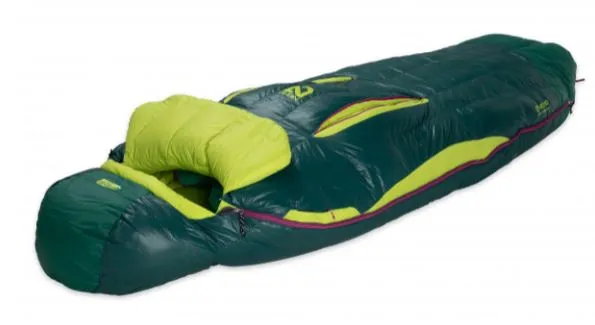
Pros: Great temperature ratings, lots of wriggle room, women’s specific fit
Cons: More expensive than similar bags, bulky for backpacking
- RRP: £399.99
- Shape: Spoon shape
- Fill: 830g fill weight, 650 fill power hydrophobic down
- Weight: 1,004g
- Packed size: 32cm x 22cm
- Comfort rating (European standard 13537): Comfort temperature –8°C (lower temperature -15°C)
The Nemo Equipment Disco Women’s Down draws you in with its attractive bright colours, and we were pleased to find it delivered in performance too. The squeezable and lofty bag offers impressive temperature ratings, ideal for a chilly autumn evening. You can also use it in the warmer months thanks to the unique Thermo Gill vents. While this kit is pricy, you've got a versatile piece of gear on your hands.
For more information, check out our full review of the Nemo Equipment Disco Women’s Down sleeping bag.
Alpkit Pipedream 400 sleeping bag
Best for backpacking or bikepacking in summer
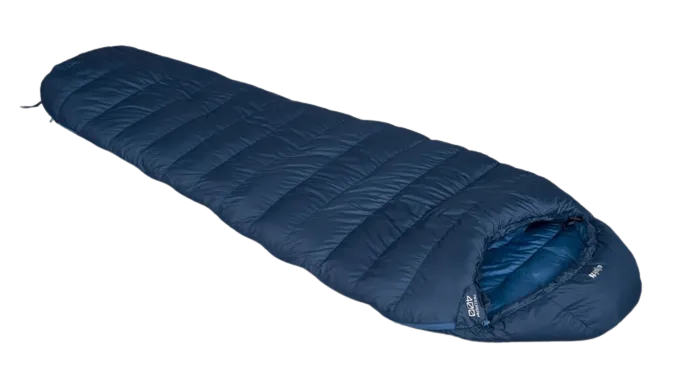
Pros: Ideal for cold evenings, lovely fabric, impressive weight to warmth ratio
Cons: Front-only shoulder baffle, no women’s specific design
- RRP: £199.99 (previously £239.99)
- Shape: Mummy
- Fill: 400g fill weight, 750 fill power hydrophobic (DownTek) goose down
- Weight: 865g
- Packed size: 19cm x 14cm
- Comfort rating (European standard 13537): Comfort temperature –4.2°C (lower temperature -10.8°C)
This three-season goose down sleeping bag is a great choice for backpacking enthusiasts. The Alpkit model is lightweight and easy to compress, allowing for light and fast camping. Snuggly too, the Pipedream 400 was one of the softest sleeping bags on test.
There's plenty of space, even for a mummy-shaped sleeping bag, but you may end up with hot feet as the zip is on the short side.
There's plenty to love about this sleeping bag, and all for a decent price.
Read our full review of the Alpkit Pipedream 400 sleeping bag.
For more of our outdoor gear reviews, check out the best camping chairs and the best pop up tents, reviewed by our team.
What to consider when buying a sleeping bag
Which is the best sleeping bag for UK camping?
If you want to carry your sleeping bag on your back or a bike, you’ll need a lightweight design that has been shaped, filled and packed for portability. For this type of camping, a down-filled, mummy-shaped sleeping bag in a compression sack will give you a good ratio of warmth to weight, as well as squashing small enough to fit in your packing system.
But such detailing can come at a cost that, if you prefer camping from a car, you might not need to pay.
To help you make your choice, we’ve tested some of the most popular and interesting sleeping bags for camping. We’ve focused on 2-season and 3-season bags, most of which, when combined with an insulated camping mattress, will give you plenty of warmth for a long season of UK summer camping.
Add to your comfort by choosing a nice comfy camping pillow and if you need a liner check out our best sleeping bag liners
Sleeping bags explained
What kinds of sleeping bags are there for camping?
Down sleeping bags
If you’re looking for a sleeping bag that is warm, weighs less and packs small, one filled with down may well be your best solution. Down is the under-feathers from ducks or geese and has plenty of loft or fluffiness with thousands of air pockets that trap warm air and retain the heat given off by your body. The quality and quantity of down in a sleeping bag is measured by fill power (fluffiness) and fill weight (amount).
Because down is an animal product, down won’t be suitable for some vegans, and it doesn’t perform as well when wet as most synthetic insulation. Some sleeping bag manufacturers treat their down with water repellent chemicals to mitigate this problem, the result is known as hydrophobic down which, although it does improve performance, can sometimes contain PFC or PFAS ‘forever’ chemicals. To safeguard animal welfare, it’s important to make sure the down used in your outdoor gear comes from a Responsible Down Standard (RDS) recognised source.
Synthetic sleeping bags
Synthetic insulation is the manmade alternative to down. A synthetic sleeping bag will usually be heavier and bulkier than a down one with the same temperature ratings, but synthetic insulation often performs better in wet conditions and can be easier to look after. Some newer synthetic insulation materials feel as soft and fluffy as down, but they are unlikely to be as warm. If you’re concerned about sustainability, keep an eye out for synthetic sleeping bags that don’t use ‘forever chemicals’ like PFASs (Perfluoroalkyls) and PFCs (Perfluorochemicals) in their production.
Mummy sleeping bags
Mummy shaped sleeping bags are tapered towards the feet. This tapering adds warmth because the body has less air space to heat up, it can also help keep the weight of a bag down. If you like to move your legs around in the night, you might find a mummy-shaped sleeping bag restrictive.
Rectangular and wide sleeping bags
Rectangular and wide sleeping bags are often too big and heavy for backpacking, but they offer a comfortable and more roomy sleep when you are camping from your car. More space inside the bag will give you wriggle room, but it might not keep you as warm as a closer fitting bag.
Sleeping bag temperature ratings
Most sleeping bags sold in Europe are sold with temperature ratings, which meet the European standard EN 13537 in laboratory tests. This makes it easier for you to choose the right product but it’s worth noting some manufacturers choose to use their own temperature recommendations. Because women tend to sleep colder than men, commercial temperature ratings relate to this.
Comfort temperature – cooler sleepers (usually women) can sleep comfortably all night in a relaxed position
Lower limit temperature – warm sleepers (usually male) can sleep comfortably all night in a curled position
Extreme temperature – a survival rating to be relied on in emergencies only – hypothermia may occur
Sleeping bag details
The details on a sleeping bag can add to the price of your purchase but they can also make the difference between a comfortable and an uncomfortable night.
A hood drawstring – will help you retain heat around your head
Shoulder baffles (insulated pads) - will keep heat in around your core
Zip baffles – will stop heat from escaping through the zip
Two-way zips – will allow you to reduce heat on a hot night
Insulation zones – will keep more heat where it is really needed
Female specific shaping – will allow space where needed but reduce wasted air pockets elsewhere
Fabric – a sticky or noisy fabric can be uncomfortable overnight
Don’t forget your camping mattress
It’s worth remembering that even the most expensive sleeping bag (especially one that relies on lofting) won’t insulate you from the ground anywhere near as well as an insulated camping mattress.
How we tested
BBC Countryfile Magazine reviewed these sleeping bags to test how they performed in real-life camping conditions. With a focus on 2-season and 3-season bags, our outdoor specialist and life-long camper considered ease of use, material, shape, sustainability, transportability and temperature rating, to test how well the sleeping bags performed. As a significant factor when finding the right sleeping bag for your camping pursuits, seasonality was also taken into account, to help you find the right levels of warmth for a comfortable and safe night’s sleep.
In the market for a new family tent? Read our review of the Berghaus Air 400XL Nightfall tent.
